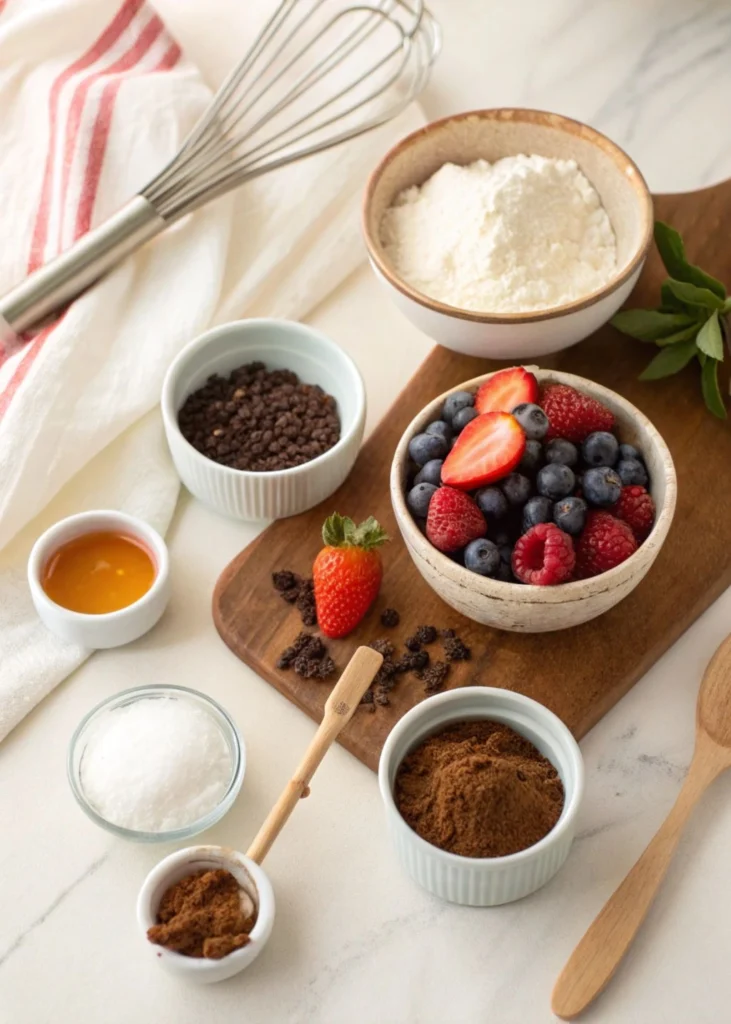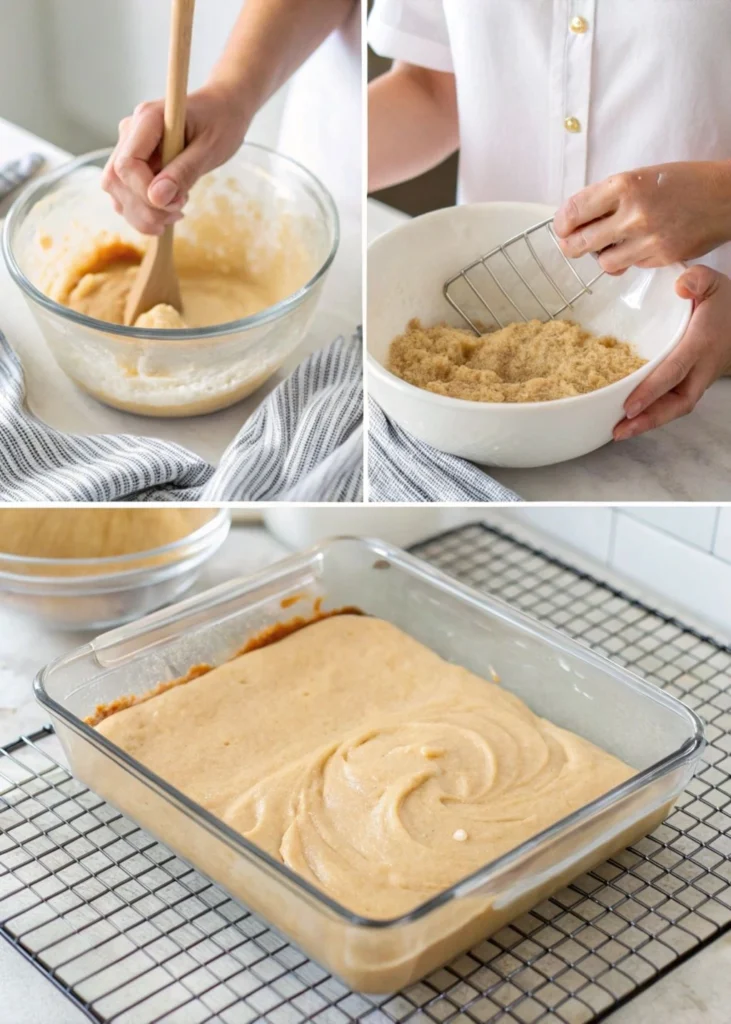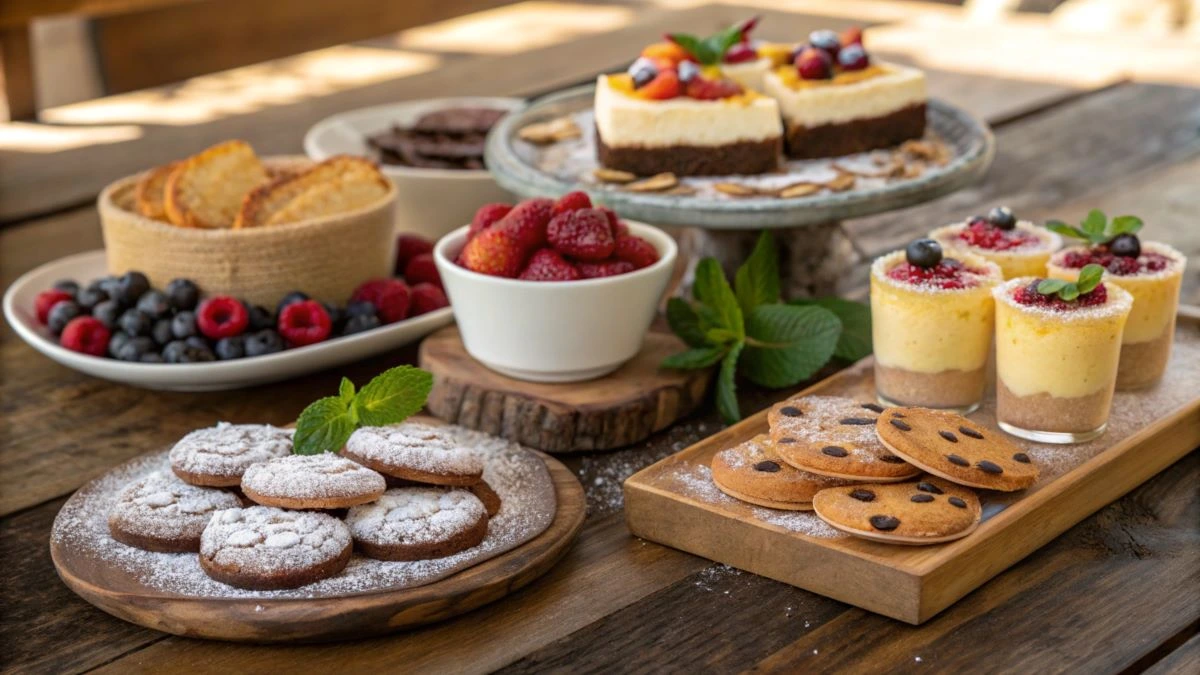Are you searching for a way to satisfy your sweet tooth without all the sugar? Look no further! Low sugar dessert recipes are the perfect solution for indulging in delicious treats while staying mindful of your health. Whether you’re managing your sugar intake or simply exploring healthier dessert options, these recipes offer the best of both worlds: incredible flavor and a guilt-free experience.
Imagine enjoying a rich, chocolatey brownie or a refreshing fruit parfait that’s just as satisfying as traditional desserts—without the sugar crash. With simple ingredients like natural sweeteners and clever substitutions, you can create mouthwatering delights that everyone will love. Let’s dive into the recipe and discover how easy it is to whip up your next favorite dessert!
Table of Contents
Quick Overview
Making desserts can often feel like a guilty pleasure, but with low sugar dessert recipes, you can have your cake and eat it too—literally! These recipes are designed to deliver all the sweetness you crave with a fraction of the sugar, making them perfect for anyone looking to embrace a healthier lifestyle.
Why choose low sugar desserts?
- Health Benefits: Reducing sugar intake can support better energy levels, improved digestion, and overall well-being.
- Versatility: From cookies to cheesecakes, low sugar options span a wide variety of treats to suit any craving.
- Dietary Adaptability: These recipes are great for those following diabetic-friendly, keto, or low-carb diets.
Whether you’re baking for a special occasion or just want a treat to enjoy with your morning coffee, this recipe will quickly become a go-to in your kitchen. Let’s get started and explore how easy and fun it is to whip up a dessert that’s both satisfying and health-conscious!
Ingredients
When it comes to low sugar dessert recipes, choosing the right ingredients is key to achieving that perfect balance of flavor and sweetness without overloading on sugar. Here’s everything you’ll need to create a delicious, guilt-free treat:

Dry Ingredients
- Almond flour (1 ½ cups): A low-carb, gluten-free option that adds a subtle nutty flavor.
- Baking powder (1 teaspoon): Helps your dessert rise and achieve a light, fluffy texture.
- Unsweetened cocoa powder (¼ cup): Adds rich, chocolatey depth without added sugar.
Wet Ingredients
- Eggs (2 large): Provide structure and moisture for your dessert.
- Greek yogurt (½ cup): A creamy, protein-rich alternative to traditional dairy.
- Vanilla extract (1 teaspoon): Enhances the overall flavor profile.
Sweeteners
- Stevia or monk fruit sweetener (¼ cup): Both are natural, low-calorie alternatives that blend seamlessly into your recipes.
- Unsweetened applesauce (½ cup): Adds natural sweetness while keeping the texture moist and tender.
Optional Add-ins
- Chopped nuts (¼ cup): For added crunch and flavor.
- Dark chocolate chips (sugar-free, ¼ cup): A touch of indulgence without the sugar overload.
Pro Tip
When working with low sugar dessert recipes, always measure ingredients accurately to ensure the right consistency and taste. Substituting ingredients? No problem—just keep the ratios in mind to maintain the balance of flavors.
Now that you’ve got your ingredients ready, let’s move on to creating a dessert that’s as satisfying as it is health-conscious!
Step-by-Step Instructions
Creating delicious low sugar dessert recipes is easier than you think! Follow these simple steps to craft a treat that’s both satisfying and health-conscious.

Step 1: Preheat and Prep
- Preheat your oven to 350°F (175°C) to ensure even baking.
- Line a baking pan with parchment paper or lightly grease it to prevent sticking.
Step 2: Mix the Dry Ingredients
- In a medium bowl, combine almond flour, baking powder, and unsweetened cocoa powder.
- Whisk the ingredients until fully blended to avoid clumps and ensure an even distribution of flavors.
Step 3: Blend the Wet Ingredients
- In a separate large bowl, beat the eggs lightly until frothy.
- Add the Greek yogurt, vanilla extract, unsweetened applesauce, and your chosen sweetener (e.g., stevia or monk fruit).
- Mix until smooth and creamy.
Step 4: Combine Wet and Dry Mixtures
- Gradually fold the dry ingredients into the wet mixture.
- Stir gently to combine, ensuring there are no dry spots. Overmixing can lead to a dense texture, so stop as soon as the batter comes together.
Step 5: Add Optional Extras
- If you’re using chopped nuts or sugar-free dark chocolate chips, fold them into the batter now. These add texture and bursts of flavor.
Step 6: Bake
- Pour the batter into your prepared pan and spread it evenly.
- Bake for 25–30 minutes, or until a toothpick inserted into the center comes out clean.
- Allow the dessert to cool in the pan for about 10 minutes before transferring it to a wire rack to cool completely.
Step 7: Serve and Enjoy
- Slice your dessert into portions and serve it as is or with a dollop of whipped cream for an extra treat.
Creating low sugar dessert recipes doesn’t just result in a healthier option—it’s a fun and rewarding experience. With these steps, you’ll have a dessert that’s sure to impress, whether it’s for a family gathering or a quiet night in!
Pro Tips and Variations
Mastering low sugar dessert recipes is all about finding the right balance of flavor and creativity. Here are some expert tips and exciting variations to elevate your dessert game:
Pro Tips
- Use Room-Temperature Ingredients
- Room-temperature eggs and yogurt blend more smoothly, ensuring a consistent texture in your batter.
- Don’t Overmix
- When combining wet and dry ingredients, stir just until incorporated. Overmixing can lead to dense or tough desserts.
- Taste Test the Sweetness
- Sweeteners like stevia and monk fruit vary in intensity. Taste your batter before baking and adjust the sweetness if needed.
- Layer Flavors for Depth
- Pair a hint of cinnamon or a dash of espresso powder with unsweetened cocoa for a richer, more complex taste.
Variations
- Keto-Friendly Version
- Swap unsweetened applesauce with melted coconut oil or avocado for a keto-compliant dessert.
- Gluten-Free Twist
- While almond flour is naturally gluten-free, you can experiment with a blend of almond and coconut flours for a slightly firmer texture.
- Nut-Free Option
- Replace almond flour with oat flour and use sunflower seed butter instead of nuts for those with allergies.
- Fruity Flair
- Fold in fresh or frozen berries like raspberries or blueberries for bursts of natural sweetness and a pop of color.
- Chocolate Lover’s Delight
- Sprinkle a layer of sugar-free chocolate chips on top before baking for an extra indulgent finish.
Experimenting with these tips and variations will not only make your low sugar dessert recipes more versatile but also cater to different tastes and dietary needs. Don’t be afraid to get creative—each tweak can lead to a delightful new version of your favorite treat!
Presentation and Serving
Presenting your low sugar dessert recipes in a visually appealing way can make all the difference, turning a simple treat into something special. Here are some tips for serving and styling your dessert to impress:
Simple Yet Elegant Plating
- Serve in Individual Portions
- Instead of slicing the dessert directly from the pan, consider serving it in individual portions. Small jars or bowls can create a charming, personal touch for each guest.
- Add Fresh Garnishes
- Top your dessert with a few fresh berries (like strawberries or raspberries) for color and a burst of natural sweetness. Fresh mint leaves or a light dusting of powdered stevia can also elevate the look.
- Create a Dessert Trio
- If you’re hosting a gathering, consider serving your low sugar dessert alongside other mini low sugar treats, like sugar-free chocolate truffles or a bite-sized fruit salad, to offer variety and keep the presentation dynamic.
Creative Serving Ideas
- Whipped Cream or Greek Yogurt
- A dollop of Greek yogurt or sugar-free whipped cream on the side can add richness and make the dessert feel more indulgent without the added sugar.
- Chocolate Drizzle
- A drizzle of melted sugar-free dark chocolate on top or along the edges of the plate can add a gourmet touch that complements the low sugar profile.
- Crispy Toppings
- Crushed low sugar granola or toasted coconut flakes can provide a crunchy contrast to the smooth texture of your dessert, adding both flavor and visual interest.
Serving Temperature
- Many low sugar dessert recipes taste best when served at room temperature, but some (like cookies or brownies) can also be enjoyed warm. For a rich, melt-in-your-mouth experience, serve your dessert slightly warmed with a scoop of sugar-free ice cream.
Serving your dessert with a personal touch can turn even the simplest low sugar treat into an unforgettable experience. Remember, it’s not just about the taste—it’s also about how you present it!
Storage Tips
Proper storage is key to ensuring your low sugar dessert recipes stay fresh and delicious for as long as possible. Here are some handy tips to keep your treats tasting great, whether you’re planning to enjoy them immediately or store them for later:
Storing Leftovers
- Cool Completely Before Storing
- Always let your dessert cool completely before storing it. This prevents excess moisture from building up, which can affect texture and flavor.
- Airtight Containers
- Store your low sugar dessert in airtight containers to lock in freshness and prevent it from drying out. Glass containers are especially great for preserving both taste and texture.
- Room Temperature vs. Refrigeration
- For desserts like cookies or cakes, you can store them at room temperature for up to 3–4 days. For a longer shelf life, refrigerate them for up to 1 week.
- Tip: If you’re storing desserts with yogurt or fresh fruit, always refrigerate to prevent spoilage.
Freezing for Longer Storage
- Freeze in Individual Portions
- If you’ve made a large batch and want to save some for later, freeze your desserts in individual portions. This makes it easy to thaw just the right amount when you’re craving something sweet.
- Wrap and Seal
- Wrap your low sugar desserts in plastic wrap or place them in freezer-safe bags. Double wrapping can help avoid freezer burn.
- Thawing Tips
- Thaw frozen desserts in the fridge overnight for best results. If you’re in a hurry, you can thaw at room temperature for a few hours. For some treats, like brownies or cookies, you can enjoy them straight from the freezer for a slightly firmer texture!
Avoiding Common Storage Pitfalls
- Don’t Store Warm Desserts: Storing a warm dessert can cause condensation, which makes it soggy or affects its flavor.
- Label Your Desserts: If you’re freezing multiple treats, label each one with the date so you know how long it’s been stored.
By following these storage tips, your low sugar dessert recipes will stay fresh, tasty, and ready to be enjoyed whenever you want a sweet treat!
Conclusion
Congratulations—you’ve just created a delicious, guilt-free dessert that proves you don’t need sugar overload to enjoy something sweet! Low sugar dessert recipes are the perfect way to indulge in your favorite treats while staying mindful of your health and wellness goals. Whether you’re managing blood sugar levels, following a low-carb lifestyle, or simply looking for a more balanced way to satisfy your sweet tooth, these recipes are a game changer.
With simple ingredients, straightforward steps, and plenty of room for creativity, you can easily tailor these desserts to your personal preferences. Plus, once you’ve mastered the basics, there’s no limit to the variations you can try—think keto-friendly, gluten-free, or even vegan adaptations!
Remember, dessert isn’t just about satisfying cravings; it’s about enjoying the process and the small moments of sweetness in life. So, the next time you’re in the kitchen, whip up one of these low sugar dessert recipes and relish every bite, knowing you’ve made a healthier choice without sacrificing flavor. Happy baking!
FAQs
Can I use regular sugar instead of a sugar substitute?
Yes, you can! However, if you’re aiming for a low sugar dessert, it’s best to use alternatives like stevia, monk fruit, or erythritol. These substitutes provide sweetness without the extra calories and sugar spikes. Keep in mind that different sweeteners have different levels of sweetness, so you might need to adjust the quantity according to your taste.
How do I make my low sugar desserts taste sweeter?
If your dessert doesn’t taste as sweet as you’d like, there are a few tricks you can try:
Add a dash of vanilla extract or cinnamon for a flavor boost.
Increase the amount of unsweetened applesauce or use a natural sweetener with a bit more flavor, like maple syrup (in moderation).
Pair with fresh fruit like berries or a small drizzle of sugar-free chocolate sauce for added sweetness without the extra sugar.
Are low sugar desserts good for diabetics?
Low sugar desserts are often a great option for those managing diabetes, as they help avoid blood sugar spikes. However, it’s important to choose natural sweeteners that have minimal impact on blood sugar levels. Always check with your doctor or nutritionist to find the best options for your personal health needs.
Can I make these desserts ahead of time?
Absolutely! In fact, many low sugar dessert recipes benefit from sitting in the fridge or freezer for a few hours to allow the flavors to meld together. Just make sure to store them properly in airtight containers to keep them fresh. Some desserts, like cookies or brownies, can even be frozen for longer storage—just let them cool completely before wrapping and freezing.
Can I substitute almond flour for another flour?
Almond flour is a popular choice for low sugar and gluten-free desserts because it adds a moist, tender crumb. If you prefer a different flour, you can try coconut flour or oat flour, but keep in mind that the texture may change slightly. Coconut flour, for example, is more absorbent, so you might need to adjust the liquid in your recipe.
How can I make my low sugar dessert more decadent?
To make your low sugar dessert recipes feel extra indulgent, try adding a rich topping, like sugar-free whipped cream, a few sugar-free chocolate chips, or even a small handful of toasted nuts. A drizzle of unsweetened chocolate sauce or a dollop of Greek yogurt can also elevate the experience.
By answering these common questions, we hope you feel even more confident in your journey to create delicious and healthy low sugar desserts. Happy baking, and enjoy the sweet satisfaction of making smarter, tastier choices!

